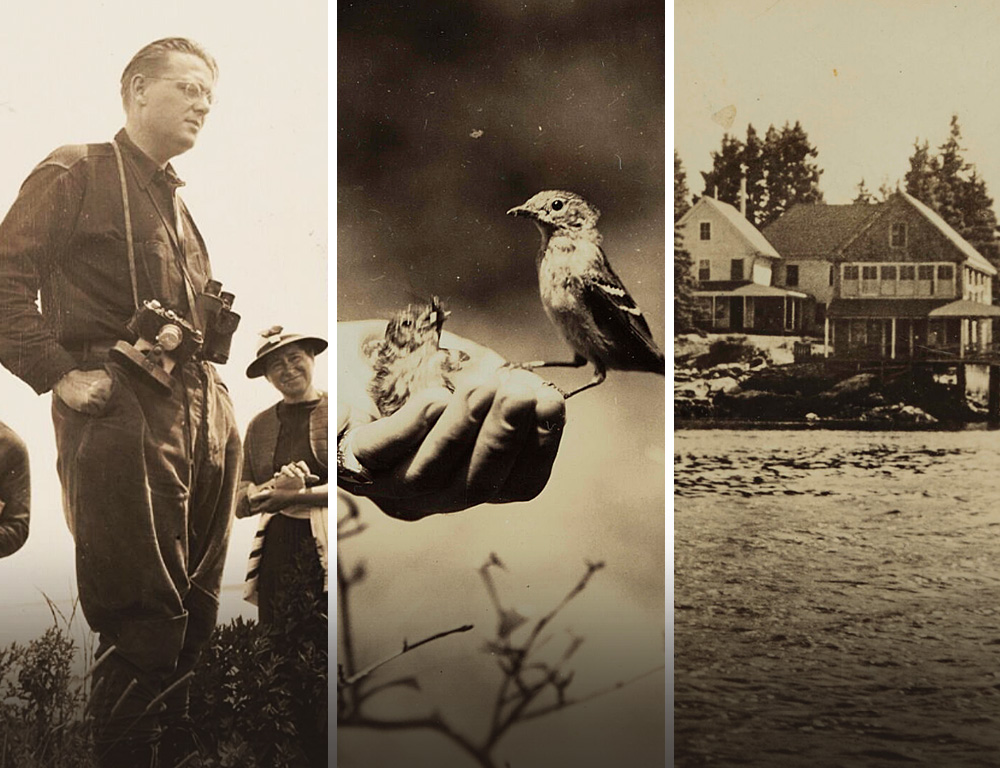Origins
History
“Just what I wanted!” exclaimed John Baker, who had recently become president of the National Association of Audubon Societies. He was speaking to Millicent Todd Bingham, who had just offered him the opportunity to purchase 33 acres on the north end of Hog Island in Muscongus Bay.
The year was 1935, and he was looking to establish a camp to train teachers and youth leaders in field ecology so that they could return to their communities and introduce this new approach to the study of natural history. Baker hired a young Latin teacher named Carl Buchheister to be the first director of this new experimental program. The camp opened in June, 1936, and was an immediate success.

Over the next 60 years, more than 50,000 adults and youngsters came to Hog Island, and their record of service to the Audubon cause has been impressive. Staff, students assistants, and campers have fanned out into leadership positions in education and many have continued work within the National Audubon Society and its chapters nationwide.
In spite of its success and a large body of loyal alumni, there was never an organized group to support the camp and its programs. The buildings and infrastructure were inherited from a summer colony, the Point Breeze Inn and Bungalows, which operated in the early years of the 20th century, and by the late 1990s they were in dire need of refurbishing. There was also need for scholarship funding and money to start an endowment.
The Friends of Hog Island originated in 1998 when former camp director Bart Cadbury and his wife Ginny, then-director Sam Hands, and Robbie Rubly-Burgraff reached out to past staff members, campers, student assistants, and friends of the Audubon Camp in Maine. Twenty-five of them, joined by then-Audubon president John Flicker, gathered at Hog Island that July to explore ways to support the camp and provide for its future welfare. Among the concerns the new group addressed were the need for a fulltime director, better advertising and marketing, and establishment of a fund to finance capital improvements and infrastructure renewal.
The following year, responsibility for the camp’s operation was transferred to Maine Audubon, which would run Hog Island through 2008. Declining registration, along with the shock of the global financial crisis, prompted Maine Audubon to close the camp.
FOHI’s Reincarnation as a Nonprofit in 2010
Hog Island reopened in 2010 under the direction of Dr. Steven Kress of National Audubon’s Project Puffin/Seabird Restoration Program. In September of that year a group of campers (Bob Horn, John White, Kayleen Pritchard, Terry Haight, Wendel Meyer, Juanita Roushdy, along with Steve Kress) gathered on the deck of The Helm to form a group to forestall the signing of the camp over to an owner other than National Audubon.
The group decided to form a nonprofit 501(c)(3), elect Juanita Roushdy as president, and to use the name of the former Friends of Hog Island, which had become moribund. They invited several of the former FOHI’s members to be on the board of the new, nonprofit FOHI.
At inception, the board comprised: President, Juanita Roushdy; Vice President, Walt Pomeroy; Treasurer, Gaye Phillips; Secretary, Loretta Victor; Directors: Kenn Kaufman, David Klinger, Steve Kress, Kayleen Pritchard, Tom Schaefer, and Scott Weidensaul.
The reincarnated FOHI formed a board, wrote by-laws, and filed its nonprofit application in October 2010.
After much negotiation and a visit to New York, the idea of transferring camp to another entity was shelved. FOHI received its nonprofit status in March 2011 and wrote a three-year business plan for the island, prompting an anonymous donor to give $500,000 to the Hog Island Endowment.In 2010, five donors contributed to the new nonprofit FOHI: Joe and Karen Bearden, Bob and Joan Horn, Robert and Gaye Phillips, Juanita Roushdy, and Amy and Scott Weidensaul. The following year that number catapulted to 302 and has continued to rise ever since. Likewise the number of volunteers and hours have risen and are an important part of FOHI’s contribution to the camp.
Beginning in June 2011 and continuing annually ever since, FOHI has contributed at least $50,000 a year in financial underwriting, as well as an average of 7,000 volunteer hours per summer. FOHI has also provided (through 2021) in-kind donations in the form of building renovations, both to the campus and the historic Bingham Cottages, equipment, plantings, and digitization of Hog Island historical documents and photos. In all, FOHI’s financial contributions have almost reached a million dollars, including $175,000 to the Hog Island Endowment.
Despite a temporary closure in 2020 because of the COVID-19 pandemic, both Hog Island and FOHI continue to thrive, while FOHI underwrites the significant expense of raising the Queen Mary (the historic 19th century ship’s chandlery) to save it from rising sea levels. Under board president Scott Weidensaul and executive director Juanita Roushdy, FOHI forges ahead.

